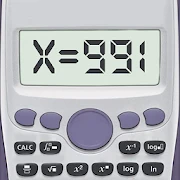How to Get Started with Scientific calculator plus 991?
- 1. **Power On/Off**: Press the ON button to turn on the calculator. Press the AC button to turn it off.
- 2. **Basic Operations**: Use the number keys and the operation keys (+, -, ×, ÷) for addition, subtraction, multiplication, and division.
- 3. **Memory Functions**:
- - M+: Add the displayed value to memory.
- - M-: Subtract the displayed value from memory.
- - MR: Recall the value from memory.
- - MC: Clear the memory.
- 4. **Scientific Notation**: Enter numbers in scientific notation using the EXP button for powers of ten (e.g., 2.5 × 10^3 is entered as 2.5 EXP 3).
- 5. **Trigonometric Functions**: Use the buttons SIN, COS, and TAN for sine, cosine, and tangent. Ensure the calculator is in the correct mode (degrees or radians).
- 6. **Exponents and Roots**: Use the ^ (power) button for exponents and the √ button for square roots.
- 7. **Calculating Statistics**: Access the STAT mode for statistics calculations, including mean, standard deviation, and regression.
- 8. **Equation Mode**: Use the EQN mode to solve simultaneous equations or quadratic equations.
- 9. **Function for Fractions**: Use the a b/c button to enter fractions directly.
- 10. **Graphing Functions**: While the calculator does not graph, it can calculate values for given functions. Use the table of values method for plotting.
- 11. **Unique Functions**: Explore additional functions like matrices, complex numbers, and conversion between different number systems.
- 12. **Refer to Manual**: For advanced features, consult the user manual for detailed instructions and examples.
- 13. **Practice**: Regular use and practice with different functions will enhance proficiency.
10 Pro Tips for Scientific calculator plus 991 Users
- 1. Utilize the "Mode" button to switch between different calculation types, such as degrees/radians for trigonometric functions or statistical modes for data analysis.
- 2. Use the "Shift" key to access secondary functions and advanced features, maximizing your calculator's capabilities.
- 3. Familiarize yourself with memory functions (M+, M-, MR, and MC) to efficiently store and recall important values throughout your calculations.
- 4. Explore the "Equation" feature to solve common equations directly without having to manipulate them manually.
- 5. Take advantage of the "Table" function to generate lists of values for functions, which is helpful for analyzing behavior across intervals.
- 6. Master the use of parentheses to ensure the correct order of operations, especially in complex calculations.
- 7. Use the "Reciprocal" function for quick calculations involving fractions, saving time on manual conversions.
- 8. Learn the shortcut commands for quick access to specific statistical functions like standard deviation and regression analysis.
- 9. Practice using the "Graphing" feature for visualizing equations and understanding the relationships between variables.
- 10. Regularly reset your calculator to clear memories and settings, which can help avoid calculation errors from residual data.
The Best Hidden Features in Scientific calculator plus 991
- **Multi-line Display**: It allows users to see multiple lines of calculations at once, making it easier to follow complex equations.
- **Equation Solving**: This feature enables users to solve equations symbolically rather than just numerically, offering step-by-step solutions.
- **Variable Storage**: Users can store and recall variables for use in calculations, which helps in simplifying long computations.
- **Statistical Calculations**: The calculator can perform regression analysis, standard deviation, and other statistical functions efficiently.
- **Matrix Computation**: It supports matrix operations, including addition, subtraction, multiplication, and finding determinants.
- **Fraction Calculation**: Users can input fractions directly and perform calculations without converting to decimal, keeping results in fraction form.
- **Complex Number Calculations**: It has the capability to handle complex numbers, allowing for addition, subtraction, multiplication, and division of complex expressions.
- **Conversion Functions**: The calculator can convert between different units and number bases, facilitating ease of calculations across various fields.
Scientific calculator plus 991 Faqs
How can I perform complex calculations with the Scientific Calculator Plus 991?
To perform complex calculations, use the multi-function keys for trigonometric, logarithmic, and exponential functions. Input the numbers and functions as required, then press 'equals' to get the result.
What is the use of the memory function in the calculator?
The memory function allows you to store intermediate results for later use. You can save a result in memory with the 'M+' key and retrieve it later using the 'MR' key.
Can I perform matrix calculations with this calculator?
Yes, you can perform matrix calculations. Select the matrix mode, define the dimensions, and input your values. Operations like addition, subtraction, and multiplication are available after entering the matrices.
How do I use the statistical functions for data analysis?
To use statistical functions, first input your data set. Then, select the statistical option based on your need, such as mean, median, or standard deviation. Follow the prompt to compute the desired statistic.
How can I perform a regression analysis on my dataset?
To perform regression analysis, follow these steps: 1. Input your X and Y data points into the calculator. 2. Select the regression analysis option from the statistics menu. 3. Choose the regression type (like linear or quadratic). 4. Calculate to get the regression equation and correlation coefficient.

1.Rate
2.Comment
3.Name
4.Email